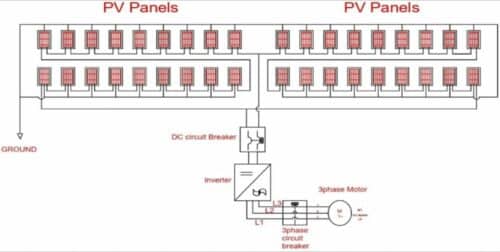- The photovoltaic (PV) water pumping system, designed by Egyptian researchers, can generate a daily water output of up to 181.8 cubic meters.
- The system is composed of two PV arrays, each boasting a capacity of 4.6 kW, along with a pumping unit that includes a 7.5 kW three-phase alternating current motor, a multistage submersible pump, a deep well, and a 15 kW inverter.

Image: Al-Azhar University, scientific reports, Creative Commons License CC BY 4.0
Photovoltaic (PV) powered water pumps, primarily designed for irrigation, offer a practical and environmentally sustainable option for fulfilling water pumping needs in distant and off-grid regions, serving as a commendable substitute for traditional diesel-powered water pumps. The envisioned system holds the potential to deliver a consistent and reliable water supply, contingent upon the comprehensive incorporation of various environmental and technical considerations into the project’s design.
Al-Azhar University’s research team in Egypt has developed an advanced photovoltaic water pumping system (PVWPS) with broad applications, including household water supply, irrigation, livestock watering, and village-wide water distribution. Their primary goal was rigorously testing the system’s reliability and performance under real-world conditions. They also aimed to identify factors affecting PV system efficiency. This innovative system, featuring two 4.6 kW PV arrays and a 7.5 kW pumping unit, is an eco-friendly and cost-effective alternative to conventional energy systems. Alternating current motor, a multistage submersible pump, a deep well, and a 15 kW inverter.
The researchers emphasised two critical parameters: the system’s hydraulic power and solar radiation intensity. Their comprehensive analysis yielded a significant insight: the efficiency of the pumping unit is influenced by several factors, namely the intensity of solar radiation, the temperature of the solar panels, and the alternating current (AC) power. The key features include:
- Each 1°C increase in temperature led to a decrease in PV panel efficiency by 0.48%.
- The pump’s power influenced the water flow rate, resulting in average hourly discharges of 18.2 m³/h (December), 22.2 m³/h (March), and 22.8 m³/h (June).
- The pump operated for 7 hours (December and March) and 8 hours (June) per day.
- Daily water pumped amounted to 129 m³ (December), 164.1 m³ (March), and 181.8 m³ (June).
- The overall average system efficiency was 7.40% (December), 8.46% (March), and 8.51% (June).
The solar panels’ DC output directly influences the inverter frequency. Researchers calculated overall system efficiency by dividing hydraulic power output by solar radiation input and multiplying component efficiencies. Findings revealed a strong link between overall efficiency and solar radiation levels. According to the research team, multiple sequential phases characterise the development process of the solar water pumping system, and to ensure its effectiveness, it necessitates the acquisition of specific data points. These crucial pieces of information encompass aspects such as daily water consumption, the static water level, as well as the length and diameter of the pumping pipes.






